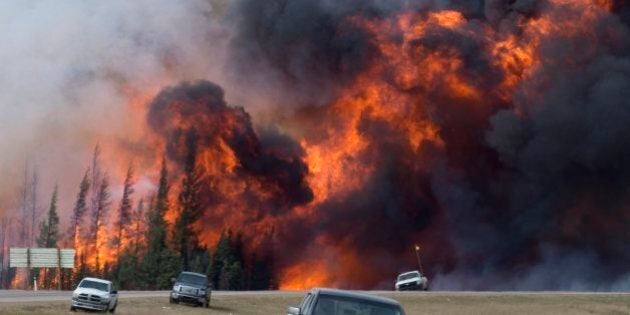
Last week I wrote a piece on my personal blog titled: On forest fires climate activist aren't just insensitive, they are also wrong which addressed some of the reporting that incorrectlyclaimed thatclimate change was responsiblefor the Fort McMurray fire.
The truth of the matter was presented by Elizabeth May:
Some reports have suggested that the wildfires are directly caused by climate change. No credible climate scientist would make this claim, and neither do I make this claim.
The reason Ms. May made that statement is that she recognizes that legitimate forest fire experts know better than to make such claims. So what do knowledgeable researchers in the field say? The go-to person on this topic is Dr. Mike Flannigan from the University of Alberta. He is an expert on fire and weather/climate interactions.
Dr. Flannigan has been very careful with his language and has repeatedly stated: " it's impossible for scientists to say global warming caused this specific fire" and "this is an example of what we expect -- and consistent with what we expect for climate change." His wording is carefully chosen and deliberate. It presents a warning about future conditions while making no claims about current conditions.
Dr. Flannigan warns of a future when, according to his research, we will be able to see the effect of climate change on fire frequency. The problem is, as he has also said, science cannot make that claim yet. So the question to be asked is why are the activists making such broad claims when the experts in the field refuse to make the same claims?
From my reading the articles it is clear that many of the journalists were not really listening to what the forest scientists, like Dr. Flannigan, were saying and were instead just looking for quotes to insert into articles that simply reinforced their pre-existing biases. They did not recognize the difference between correlation and causation and so failed to understand what the forest scientists were trying to tell them.
A number of climate activists, meanwhile, are apparently confused by the weather in Alberta. They do not appear to understand that El Nino, not climate change, is responsible for the warm, dry winter. This fact was well-expected as experts predicted the warm, dry winter months ago.
In a final attempt to link climate change to the fire, many activists have alternatively claimed that the recent El Nino itself is the result of climate change. But when you ask the experts they dismiss that claim as well. Consider Dr. Fredolin Tangang who served from 2008 to 2015 as vice-chair of the Intergovernmental Panel on Climate Change (IPCC), and is one of the foremost international experts on El Nino. As he put it:
There is no conclusive evidence that the occurrence of El Nino (frequency and intensity) is influenced by climate change...El Nino occurrences did not switch in frequency or intensity due to climate change.
Dr. Tangang does acknowledge that an El Nino can enhance the effects of climate change. To paraphrase Dr. Tangang: El Nino frequencies and intensities are not linked to climate change but since El Nino will heat up an area it could have an additive effect. That is, if an area is already hot, then El Nino will make it hotter.
So what actually caused the fire to be so severe? Well it appears to be a combination of the effects of El Nino and historic forest management decisions. To explain: after the Slave Lake fire in 2011 the Alberta Government sought advice on the fire situation. The result was the Flat Top Complex Wildfire Review Committee Report which made a number of recommendations and concluded:
Before major wildfire suppression programs, boreal forests historically burned on an average cycle ranging from 50 to 200 years as a result of lightning and human-caused wildfires. Wildfire suppression has significantly reduced the area burned in Alberta's boreal forests. However, due to reduced wildfire activity, forests of Alberta are aging, which ultimately changes ecosystems and is beginning to increase the risk of large and potentially costly catastrophic wildfires.
Essentially the report acknowledged that the trees surrounding Fort McMurray are hard-wired for fire and if they are not managed properly then these types of catastrophic fires will become more common. The warm weather may have accelerated the fires season, but the stage was set for such a fire and not enough work was done to avoid it.
I have been repeatedly asked: "what does it hurt to say that the fire was caused by climate change?" Well, the whole point of the Flat Top Complex Report (which was written in 2011-2012 remember) was to help identify ways to avoid future catastrophic fires like the one that hit Fort McMurray.
As a pragmatist I recognize that we live in a world where our governments have finite budgets and need to allocate resources wisely; to do that they need good information. Bad information makes for bad decisions, and attributing the forest fire to climate change would mean advancing bad information over good. That can only increase the likelihood that policy-makers will make poor decisions which we can all agree is not something we want to see.
Follow HuffPost Canada Blogs on Facebook
ALSO ON HUFFPOST:
